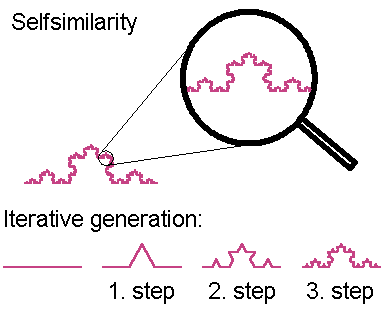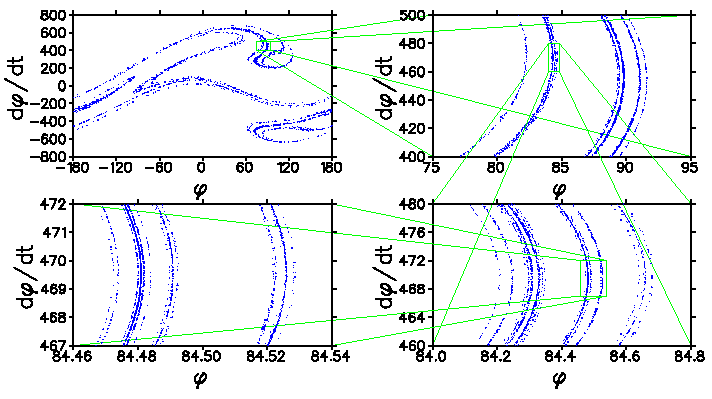|
|
|
 A fractal is a geometric object which looks similar to itself under a magnifying glass.
This selfsimilarity is a property which is very well illustrated by the Koch curve
or snow flake curve. As it is shown in figure, it is generated by an iterative process.
Even though the Koch curve is bound (i.e., you can draw a circle with
finite radius around it), its length is infinite.
Of course, if your magnifying glass has only finite resolution,
the curve has finite length. That is, if you measure the length with a ruler of finite
length l, you will find that the length L of the Koch curve is also finite.
But if you take a smaller ruler, you will see more details leading to a greater length.
Thus, L is a decreasing function of l. How does it depend on l?
Imagine you have a set of rulers. The biggest one just spans from one end of the
Koch curve to the other one. It defines the length unit. The second largest ruler is just
one third of the biggest one. The third largest ruler is one third of the second largest,
etc. How long is the Koch curve measured with nth largest ruler? It is just the
length of the nth iterate. Thus, the length of the Koch curve measured with the
second largest ruler is four times the length of the second largest ruler, i.e., 4/3.
Here is a table with the results for other iterates:
A fractal is a geometric object which looks similar to itself under a magnifying glass.
This selfsimilarity is a property which is very well illustrated by the Koch curve
or snow flake curve. As it is shown in figure, it is generated by an iterative process.
Even though the Koch curve is bound (i.e., you can draw a circle with
finite radius around it), its length is infinite.
Of course, if your magnifying glass has only finite resolution,
the curve has finite length. That is, if you measure the length with a ruler of finite
length l, you will find that the length L of the Koch curve is also finite.
But if you take a smaller ruler, you will see more details leading to a greater length.
Thus, L is a decreasing function of l. How does it depend on l?
Imagine you have a set of rulers. The biggest one just spans from one end of the
Koch curve to the other one. It defines the length unit. The second largest ruler is just
one third of the biggest one. The third largest ruler is one third of the second largest,
etc. How long is the Koch curve measured with nth largest ruler? It is just the
length of the nth iterate. Thus, the length of the Koch curve measured with the
second largest ruler is four times the length of the second largest ruler, i.e., 4/3.
Here is a table with the results for other iterates:
|
Thus, the length L of the Koch curve diverges for
l 0
like a power law, i.e.,
0
like a power law, i.e.,
where
Kneading the phase space in a dissipative dynamical system leads to a non-wandering set which is also a fractal. It is called a strange attractor if it is an asymptotically stable set. The figure below shows the strange attractor of the horizontally driven pendulum. The sequence of blow-ups clearly shows its fractal nature.
 = 1/sec,
= 1/sec,
| QUESTIONS worth to think about: |
|